Angels sleeping - Gottfried Helnwein in the Rudolfinum Gallery
Jul 2, 14:56 Filed under prague-events
 Works by Austrian artist Gottfried Helnwein are now to be seen in the Rudolfinum Gallery on the exhibition entitled Angels sleeping. He is a phenomenon in a field of hyperrealistic painting. Working in a technique of oil and acrylic painting, he makes extremely precise canvases of a big measure, based on photographs. Their topics are taken from history as well as from pop-culture and he also often deals with theme of a child in extreme situations. The realistic look of painting is startling; he is very precise and technically extremely skilful. But the paintings look bit too strange… well, but I let you to make your opinion on your own, after the visit of the exhibition.
Works by Austrian artist Gottfried Helnwein are now to be seen in the Rudolfinum Gallery on the exhibition entitled Angels sleeping. He is a phenomenon in a field of hyperrealistic painting. Working in a technique of oil and acrylic painting, he makes extremely precise canvases of a big measure, based on photographs. Their topics are taken from history as well as from pop-culture and he also often deals with theme of a child in extreme situations. The realistic look of painting is startling; he is very precise and technically extremely skilful. But the paintings look bit too strange… well, but I let you to make your opinion on your own, after the visit of the exhibition.
The exhibition in Rudolfinum is divided into five sections. Firs one shows portraits of the artist’s bandaged face, in the second part are paintings with references to the Nazi past of Austria, both the third and fourth sections have a child in different strange situations as their central subject. The fifth part differs from other ones, as it consists not of hyperrealistic paintings, which look almost as photographs, but it consists photographs itself – showing Marylin Manson as a strange icon of popculture.
Some of works exhibited here are loaned from the property of Gottfried Helwein, some from both public and private collections, and there is a big and representative among of them. I did not really like them, but if you are into hyperrealism, you definitelly should see it. Also it is worth to know, that exhibitions in Rudolfinum are always quite important, as it is one of top exhibiting places in Prague.
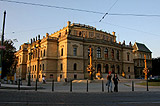 The exhibition is to be seen from 11th of June to 31st of August. The Rudolfinum Gallery is opened daily except Mondays, always from 10 am to 6 pm. The entrance fee is 120 Czk full price and 60 Czk reduced fee (students, seniors), children under 15 years old are for free. The Rudolfinum Gallery is accessible form Alsovo nabrezi, but is located in the Rudulfinum building, which is located on Jana Palacha Square, best accessible form Staromestska or Malostranska tram stations (both green line) or eventually also from bus or tram stations (Staromestska – trams 17 and 18, Malostranska – 12, 18, 22, 23, 12, 20).
The exhibition is to be seen from 11th of June to 31st of August. The Rudolfinum Gallery is opened daily except Mondays, always from 10 am to 6 pm. The entrance fee is 120 Czk full price and 60 Czk reduced fee (students, seniors), children under 15 years old are for free. The Rudolfinum Gallery is accessible form Alsovo nabrezi, but is located in the Rudulfinum building, which is located on Jana Palacha Square, best accessible form Staromestska or Malostranska tram stations (both green line) or eventually also from bus or tram stations (Staromestska – trams 17 and 18, Malostranska – 12, 18, 22, 23, 12, 20).
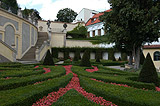
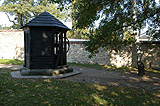
 The chateau hosts a permanent exhibition of Asian art. The ground floor is mostly Japanese. Every room is supplied with a thorough, well- written commentary in Czech and English; each room is mostly devoted to a single theme, period or a major technique. The various influences are interesting, for example the similarities between 19th Century Japanese ceramics and the European art noveau decorations, or the very early hints of the comic- book style of drawing. There are some very old sheets with of a storyboard- like character, where a series of pictures tells the story of an ancient legend, the short comments written on a side.
The chateau hosts a permanent exhibition of Asian art. The ground floor is mostly Japanese. Every room is supplied with a thorough, well- written commentary in Czech and English; each room is mostly devoted to a single theme, period or a major technique. The various influences are interesting, for example the similarities between 19th Century Japanese ceramics and the European art noveau decorations, or the very early hints of the comic- book style of drawing. There are some very old sheets with of a storyboard- like character, where a series of pictures tells the story of an ancient legend, the short comments written on a side.  Quite recently, there was opened a new aqua leisure center in Barrandov Prague district. It is quite small “aquapark”, but quite pleasant and thus offers a nice way how to spend your free time, especially with children. There are two quite long toboggans, one classical whirpool with hot water and a kind of pool with something like “a bit wild water”, plus there is a normal pool of 25 m in length and a small pool for little kids. So every member of the family can find here something he or she likes.
Quite recently, there was opened a new aqua leisure center in Barrandov Prague district. It is quite small “aquapark”, but quite pleasant and thus offers a nice way how to spend your free time, especially with children. There are two quite long toboggans, one classical whirpool with hot water and a kind of pool with something like “a bit wild water”, plus there is a normal pool of 25 m in length and a small pool for little kids. So every member of the family can find here something he or she likes.  I went to the Aquadream with my friends on Friday evening last week, and I quite liked it there. It was fun to go on toboggans (and they are quite save because there is a light system which avoids people to hit to each other on the way, you can take your ride only when the green light is on), and the whirpool was very relaxing, just to be have a rest and chat with friends. Only the swimming pool is pretty small, so it is not really suitable for some “big swimming”. Unfortunately the bar by the cash desk, at the entrance/exit room was already closed when we were leaving so I do not know much what they offer and it is good, we just bought some biscuits in the automatic machines, which are also there. And they also have vapor rooms, but we did not try them on Friday, maybe next time.
I went to the Aquadream with my friends on Friday evening last week, and I quite liked it there. It was fun to go on toboggans (and they are quite save because there is a light system which avoids people to hit to each other on the way, you can take your ride only when the green light is on), and the whirpool was very relaxing, just to be have a rest and chat with friends. Only the swimming pool is pretty small, so it is not really suitable for some “big swimming”. Unfortunately the bar by the cash desk, at the entrance/exit room was already closed when we were leaving so I do not know much what they offer and it is good, we just bought some biscuits in the automatic machines, which are also there. And they also have vapor rooms, but we did not try them on Friday, maybe next time. 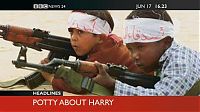 On the wall there are advertising posters-like looking pictures of some people. Maybe you do not know them, but they are important personas of Czech political or economical life. There is
On the wall there are advertising posters-like looking pictures of some people. Maybe you do not know them, but they are important personas of Czech political or economical life. There is 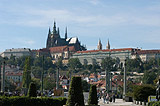 The first place on the list went to Milford Sound at New Zealand, from European places was best Rhodos in Greece, which got 5th position. Prague got 62nd position, if we would consider only European places, then it would be the 21st. Is it good or bad?
The first place on the list went to Milford Sound at New Zealand, from European places was best Rhodos in Greece, which got 5th position. Prague got 62nd position, if we would consider only European places, then it would be the 21st. Is it good or bad?  Several cities, including the capital, have seen demonstrations against the plan. The opposition arouses from both sentiment and reason. Speaking of sentiment, any foreign station in the Republic is out of the question for many. The reasoning is based on some kind of stance towards the US policies and the position of Czech Republic in the world today. The supporters base their argument on the need to strengthen the Czech- US ties. The opposition claims that is not necessary and warns of a new arms race. For both it is mostly a question of principle. For part of the Czech public it also a matter of sour memories it brings back to life.
Several cities, including the capital, have seen demonstrations against the plan. The opposition arouses from both sentiment and reason. Speaking of sentiment, any foreign station in the Republic is out of the question for many. The reasoning is based on some kind of stance towards the US policies and the position of Czech Republic in the world today. The supporters base their argument on the need to strengthen the Czech- US ties. The opposition claims that is not necessary and warns of a new arms race. For both it is mostly a question of principle. For part of the Czech public it also a matter of sour memories it brings back to life.